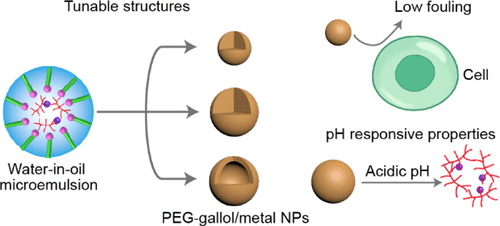当前位置:
X-MOL 学术
›
Biomacromolecules
›
论文详情
Our official English website, www.x-mol.net, welcomes your
feedback! (Note: you will need to create a separate account there.)
Microemulsion-Assisted Templating of Metal-Stabilized Poly(ethylene glycol) Nanoparticles
Biomacromolecules ( IF 5.5 ) Pub Date : 2020-12-18 , DOI: 10.1021/acs.biomac.0c01463 Gan Lin 1 , Christina Cortez-Jugo 1 , Yi Ju 1 , Quinn A Besford 1, 2 , Timothy M Ryan 3 , Shuaijun Pan 1 , Joseph J Richardson 1 , Frank Caruso 1
Biomacromolecules ( IF 5.5 ) Pub Date : 2020-12-18 , DOI: 10.1021/acs.biomac.0c01463 Gan Lin 1 , Christina Cortez-Jugo 1 , Yi Ju 1 , Quinn A Besford 1, 2 , Timothy M Ryan 3 , Shuaijun Pan 1 , Joseph J Richardson 1 , Frank Caruso 1
Affiliation

|
Poly(ethylene glycol) (PEG) is well known to endow nanoparticles (NPs) with low-fouling and stealth-like properties that can reduce immune system clearance in vivo, making PEG-based NPs (particularly sub-100 nm) of interest for diverse biomedical applications. However, the preparation of sub-100 nm PEG NPs with controllable size and morphology is challenging. Herein, we report a strategy based on the noncovalent coordination between PEG–polyphenolic ligands (PEG–gallol) and transition metal ions using a water-in-oil microemulsion phase to synthesize sub-100 nm PEG NPs with tunable size and morphology. The metal–phenolic coordination drives the self-assembly of the PEG–gallol/metal NPs: complexation between MnII and PEG–gallol within the microemulsions yields a series of metal-stabilized PEG NPs, including 30–50 nm solid and hollow NPs, depending on the MnII/gallol feed ratio. Variations in size and morphology are attributed to the changes in hydrophobicity of the PEG–gallol/MnII complexes at varying MnII/gallol ratios based on contact angle measurements. Small-angle X-ray scattering analysis, which is used to monitor the particle size and intermolecular interactions during NP evolution, reveals that ionic interactions are the dominant driving force in the formation of the PEG–gallol/MnII NPs. pH and cytotoxicity studies, and the low-fouling properties of the PEG–gallol/MnII NPs confirm their high biocompatibility and functionality, suggesting that PEG polyphenol–metal NPs are promising systems for biomedical applications.
中文翻译:

金属稳定的聚乙二醇纳米颗粒的微乳液辅助模板化
众所周知,聚乙二醇(PEG)赋予纳米颗粒(NP)低污染和类似隐身的特性,可以降低体内免疫系统的清除率,从而使基于PEG的NP(尤其是小于100 nm)成为人们关注的焦点。多种生物医学应用。然而,具有可控制的大小和形态的低于100 nm的PEG NPs的制备具有挑战性。在本文中,我们报告了一种基于油包水微乳液相的PEG-多酚配体(PEG-gallol)与过渡金属离子之间非共价配位的策略,以合成尺寸可调且形态可调的100 nm以下PEG NP。金属与酚的配位驱动PEG-丙醇/金属NP的自组装:Mn II之间的络合微乳液中的PEG-胆甾醇可产生一系列金属稳定的PEG NP,包括30–50 nm的固体和空心NP,具体取决于Mn II /胆甾醇的进料比。尺寸和形态的变化归因于基于接触角测量结果,在不同的Mn II / Gallol比下,PEG-Gallol / Mn II复合物的疏水性变化。小角度X射线散射分析可用于监测NP演化过程中的粒径和分子间相互作用,结果表明,离子相互作用是PEG-胆甾醇/ Mn II NP形成的主要驱动力。pH和细胞毒性研究,以及PEG–Gallol / Mn II的低污染特性 NPs证实了其高生物相容性和功能性,这表明PEG多酚金属NPs是有前途的生物医学应用系统。
更新日期:2021-02-08
中文翻译:

金属稳定的聚乙二醇纳米颗粒的微乳液辅助模板化
众所周知,聚乙二醇(PEG)赋予纳米颗粒(NP)低污染和类似隐身的特性,可以降低体内免疫系统的清除率,从而使基于PEG的NP(尤其是小于100 nm)成为人们关注的焦点。多种生物医学应用。然而,具有可控制的大小和形态的低于100 nm的PEG NPs的制备具有挑战性。在本文中,我们报告了一种基于油包水微乳液相的PEG-多酚配体(PEG-gallol)与过渡金属离子之间非共价配位的策略,以合成尺寸可调且形态可调的100 nm以下PEG NP。金属与酚的配位驱动PEG-丙醇/金属NP的自组装:Mn II之间的络合微乳液中的PEG-胆甾醇可产生一系列金属稳定的PEG NP,包括30–50 nm的固体和空心NP,具体取决于Mn II /胆甾醇的进料比。尺寸和形态的变化归因于基于接触角测量结果,在不同的Mn II / Gallol比下,PEG-Gallol / Mn II复合物的疏水性变化。小角度X射线散射分析可用于监测NP演化过程中的粒径和分子间相互作用,结果表明,离子相互作用是PEG-胆甾醇/ Mn II NP形成的主要驱动力。pH和细胞毒性研究,以及PEG–Gallol / Mn II的低污染特性 NPs证实了其高生物相容性和功能性,这表明PEG多酚金属NPs是有前途的生物医学应用系统。











































 京公网安备 11010802027423号
京公网安备 11010802027423号